Haryana Board Class 6 Maths Solutions For Chapter 3 Playing With Numbers
- Divisibility Rule:
The process of checking whether a number is divisible by a given number or not with actual division is called ‘Divisibility rule’ for that number. - A number is completely divisible by another number when it leaves zero as remainder.
- A number is divisible by 2 if it has the digits 0, 2, 4, 6 or 8 in its ones place.
- If the sum of the digits in a number is a mul- tiple of 3 then the number is divisible by 3.
- If a number is divisible by both 2 and 3 then it is also divisible by 6.
- A number is divisible by 9, if the sum of the digits of the number is divisible by 9.
- A number is divisible by 5, if and only if its last digit is either 5 or 0.
- A number is divisible by 10, if and only if its last digit is 0.
- If the number formed by the last two digits of the given number is divisible by 4, then the given number is divisible by 4.
- If the number formed by the last three digits of the given number is divisible by 8, then the given number is divisible by 8.
- A number is divisible by 11 if and only if the difference of the numbers obtained on adding the alternate digits of the number is either O or divisible by 11.
Factors: - A number which divides the other number without remainder is called a ‘factor’.
- 1 is factor of every number and is the smallest of all factors.
- Every number is a factor of itself and is the greatest of its factors.
- Every factor is less than or equal to the given number.
- Number of factors of a given number are countable.
- Every number is a multiple of itself.
- Every number is multiple of each of its factors.
- Every multiple of a given number is greater than or equal to that number.
- The number other than 1, with only factors namely 1 and the number itself is called a “Prime number”.
- Numbers that have more than two factors are called “Composite numbers”.
- ‘1’ is neither prime nor composite.
- Finding prime numbers, easy method was given by the Greek Mathematician “Eratosthenes”.
- The smallest even prime number is 2.
- Every prime number other than 2 is odd.
- The numbers which have only 1 as the common factor are called “Co-primes” or “relatively prime”.
- Only two primes are co-primes but all the co-primes need not be primes.
- “Twin primes” are prime numbers that differ from each other by two.
- A number divisible by two coprime numbers is divisible by their product also.
- If a number is divisible by another number then it is divisible by each of the factors of that number.
- When a number is expressed as a product of its factors we say that the number has been factorized. The process of finding the factors is called ‘factorization’.
- Methods of prime factorization :
- Division Method
- Factor Tree Method.
- “Common factors” are those numbers which are factors of all the given numbers.
- HCF – Highest Common Factor
- GCD – Greatest Common Divisor
- The Highest Common Factor (HCF) of two or more given numbers is the highest (or greatest) of their common factors. It is also called Greatest Common Divisor (GCD).
- Methods for finding HCF:
- Prime Factorization Method
- Continued Division Method.
- The method of division was invented by the famous Greek Mathematician “Euclid”.
- Continued division method is useful to find the HCF of large numbers.
- LCM – Lowest Common Multiple
- The Lowest Common Multiple (LCM) of two or more given numbers is the lowest of their common multiples.
- Methods for finding LCM:
- Prime Factorization Method
- Division Method
- If one of the two given numbers is a multiple of the other, then the greater number will be their LCM.
- Relation between LCM and HCF : Product of LCM and HCF of the two numbers Product of the two numbers.
- 1221 is a “Palindrome number”.
- If two numbers are divisible by a number then their sum and difference are also divisible by that number.
- A factor of a number is an exact divisor of that number.
- The number of multiples of a given number are infinite.
- Every number is a multiple of itself.
- A number for which sum of all its factors is equal to twice the number is called a perfect number.
- The least perfect number is 6.
- The numbers 2, 4, 6, 8, 10, ………… are called even numbers.
- The numbers 1, 3, 5, 7, numbers ……. are called odd
Find the possible factors of 45, 30 and 36.
Solution. Factors of 45 are 1, 3, 5, 9, 15, 45.
Factors of 30 are 1, 2, 3, 5, 6, 10, 15, 30.
Factors of 36 are 1, 2, 3, 4, 6, 9, 12, 18, 36.
Haryana Board Class 6 Maths Solutions For Chapter 3 Playing With Numbers Exercise-3.1
Question 1. Write all the factors of the following numbers:
Solution. a) 24
24 = 1 × 24
24 = 2 × 12
24 = 3 x 8
24 = 4 × 6
Factors of 24 are 1, 2, 3, 4, 6, 8, 12, 24.
Haryana Board Class 6 Maths Playing With Numbers solutions
b) 15
15 = 1 × 15
15 = 3 × 5
Factors of 15 are 1, 3, 5, 15.
Factors of 36 are 1, 2, 3, 4, 6, 9, 12, 18
c) 21
21 = 1 × 21
21 = 3 × 7
Factors of 21 are 1, 3, 7 and 21.
d) 27
27 = 1 × 27
27 = 3 × 9
Factors of 27 are 1, 3, 9 and 27.
e) 12
12 = 1 × 12
12 = 2 × 6
12 = 3 × 4
Factors of 12 are 1, 2, 3, 4, 6 and 12.
f) 20
20 = 1 × 20
20 = 2 x 10
20 = 4 x 5
Factors of 20 are 1, 2, 4, 5,10 and 20.
g) 18
18 = 1 x 18
18 = 2 x 9
18 = 3 x 6
Factors of 18 are 1, 2, 3, 6, 9 and 18.
h) 23
23 = 1x 23
Factors of 23 are 1 and 23.
i) 36
36 = 1 x 36
36 = 2 x 18
36 = 3 x 12
36 = 4 x 9
36 = 6 x 6
Factors of 36 are 1, 2, 3, 4, 6, 9, 12, 18 and 36.
Question 2. Write first five multiples of:
a) 5
Solution. The first five multiples of 5 are 5, 10, 15, 20, 25.
b) 8
Solution. The first five multiples of 8 are 8, 16, 24, 32 and 40.
c) 9
Solution. The first five multiples of 9 are 9, 18, 27, 36 and 45.
Question 3. Match the items in column – 1 with the items in column – 2
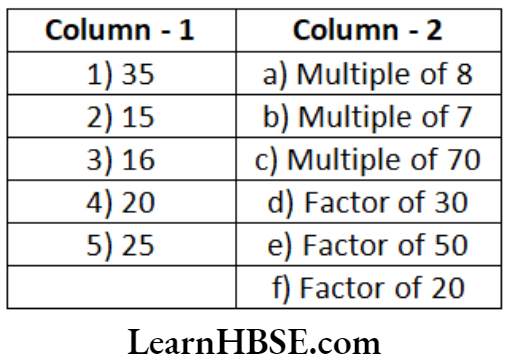
Solution. 1-b, 2-d, 3-a, 4-f, 5-e.
Question 4. Find all the multiples of 9 upto 100.
Solution. The multiples of 9 upto 100 are, 9, 18, 27, 36, 45,54, 63, 72, 81, 90 and 99.
Question 5. Observe that 2 x 3 + 1 = 7 is a prime number. Here, 1 has been added to a multiple of 2 to get a prime number. Can you find some more numbers of this type?
Solution. 2 × 5 + 1 = 10 + 1 = 11, Prime number
2 x 6 + 1 = 12 + 1 = 13, Prime number
2 x 8 + 1 = 16 + 1 = 17, Prime number
2 × 9 + 1 = 18 + 1 = 19, Prime number
2 x 11 + 1 = 22 + 1 = 23, Prime number
Haryana Board Class 6 Maths Solutions For Chapter 3 Playing With Numbers Exercise 3.2
Question 1. What is the Sum of any two
a) Odd numbers
Solution. The sum of any two odd numbers is an even number.
b) Even numbers
Solution. The sum of any two even numbers is an even number.
Question 2. State whether the following statements are True (T) or False (F).
a) The sum of three odd numbers is even.
Solution. False. [For eg: 3 +5 +9 = 17 is an odd number.]
b) The sum of two odd numbers and one even number is even..
Solution. True.
c) The product of three odd numbers is odd.
Solution. True.
d) If an even number is divided by 2, the quotient is always odd.
Solution. False. [Even numbers are those which are divided by 2. The quotient need not always be odd.]
e) All prime numers are odd.
Solution. False [The prime number 2 is an even number]
f) Prime numbers do not have any factors.
Solution. False.
HCF and LCM Class 6 HBSE Maths
g) Sum of two prime numbers is always even.
Solution. False. [For eg. The total of two prime numbers 2 and 3 is not an even number.]
h) 2 is the only even prime number.
Solution. True.
i) All even numbers are composite numbers.
Solution. False.
j) The porduct of two even numbers is always even.
Solution. True.
Question 3. The numbers 13 and 31 are prime numbers. Both these numbers have same digits 1 and 3. Find such pairs of prime numbers upto 100.
Solution. 17, 71; 37,73; 79,97.
Question 4. Write down separately the prime and composite numbers less than 20.
Solution.
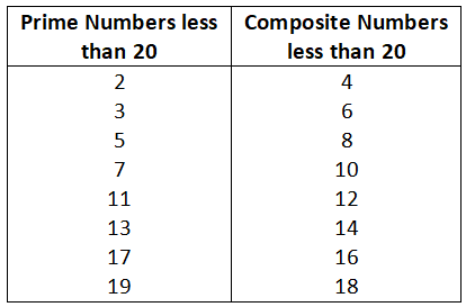
Question 5. What is the greatest prime number between 1 and 10?
Solution. The greatest prime number between 1 and 10 is 7.
Question 6. Express the following as the sum of two odd primes.
a) 44
Solution. 44 = 7 + 37
b) 36
Solution. 36 = 7 + 29
c) 24
Solution. 24 = 5 + 19
d) 18
Solution. 18 = 5 + 13 and 7 + 11
Question 7. Give three pairs of prime numbers whose difference is 2. (Remark: Two prime numbers whose difference is 2 are called twin primes)
Solution. The three pairs of prime numbers whose difference is 2 are. 3, 5; 5, 7:11, 13.
Question 8. Which of the following numbers are prime?
a) 23
b) 51
c) 37
d) 26
Solution. 23, 37 are prime numbers.
Question 9. Write seven consecutive composite numbers less than 100 so that there is no prime number between them.
Solution. 90, 91, 92, 93, 94, 95, 96.
Question 10. Express each of the following numbers as the sum of three odd primes:
a) 21
b) 31
c) 53
d) 61
Solution.
a) 21 = 3 + 7 + 11
b) 31 = 7 + 11 + 13
c) 53 = 11 + 13 + 29
d) 61 = 11 + 13 + 37
Question 11. Write five pairs of prime numbers less than 20 whose sum is divisible by 5.
(Hint: 3 + 7 = 10)
Solution. 2. 3; 2, 13: 3, 7:3, 17; 11, 19.
Question 12. Fill in the blanks:
a) A number which has only two factors is called a …
Answer. Prime Number
b) A number which has more than two factors is called a
Answer. Composite Number
c) 1 is neither………nor………….
Answer. Prime, Composite
d) The smallest prime number is….
Answer. 2
e) The smallest composite number is
Answer. 4
f) The smallest even number is…
Answer. 2
Haryana Board Class 6 Maths Solutions For Chapter 3 Playing With Numbers Exercise-3.3
Question 1. Using divisibility tests, determine which of the following numbers are divisible by 2, by 3, by 4, by 5, by 6, by 8, by 9, by 10, by 11 (say: yes or no)
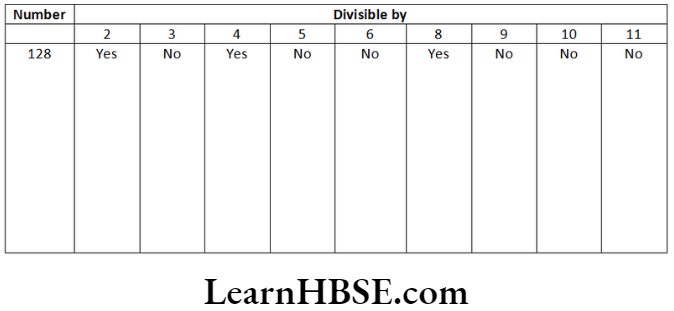
Solution.
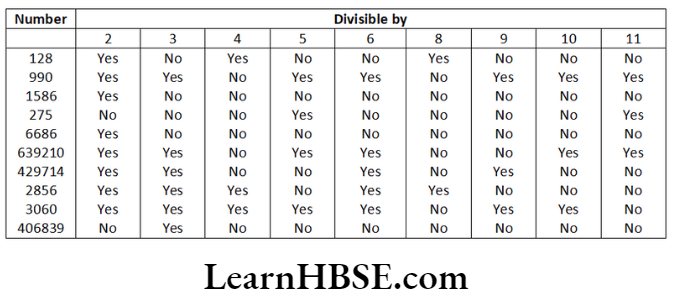
Question 2. Using divisibility tests, determine which of the following numbers are divisible by 4; by 8:
a) 572
b) 726352
c) 5500
d) 6000
e) 12159
f) 14560
g) 21084
h) 31795072
i) 1700
j) 2150
Solution. a) 572
1) Test for divisibility by 4:
Number with last two digits = 72
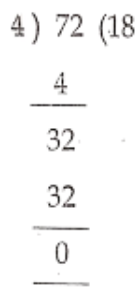
∴ 72 is divisible by 4.
∴ 572 is divisible by 4.
Last two digits are divisible by 4, givne number is divisible by 4.
2) Test for divisibility by 8
Number with last three digits = 572
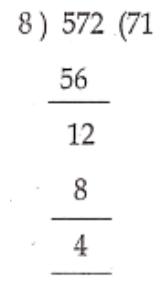
Remainder is not zero.
∴ 572 is not divisible by 8.
Last three digits are divisible by 8. So given number is divisible by 8.
b) 726352
1) Test for divisibility by 4:
Number with last two digits = 52

The remainder is zero.
∴ 52 is divisible by 4
∴ 726352 is divisible by 4.
2) Test for divisibility by 8:
Number with last three digits = 352
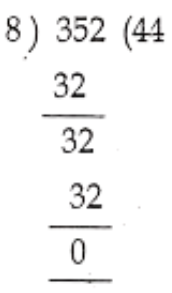
The remainder is 0, 352 is divisible by 8.
∴ 726352 is divisible by 8.
Prime and composite numbers Class 6 HBSE
c) 5500
1) Test for divisibility by 4:
As the last two digits are ‘0’ and.
‘0’ is divisible by 4
∴ 5500 is divisible by 4.
2) Test for divisibility by 8:
Number with last three digits = 500
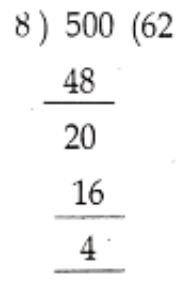
The remainder is not zero.
∴ 500 is not divisible by 8
∴ 5500 is not divisible by 8.
d) 6000
1) Test for divisibility by 4:
The number with last two digits is 00, always divisible by 4.
∴ 6000 is divisible by 4.
2) Test for divisibility by 8:
The number with last three digits is 000, always divisible by 8.
∴ 6000 is divisible by 8.
e) 12159
1) Test for divisibility by 4:
The number with last two digits = 59
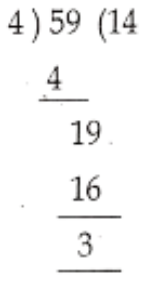
The remainder is not zero.
∴ 59 is not divisible by 4.
∴ 12159 is not divisible by 4.
2) Test for divisibility by 8:
The number with last three digits = 159
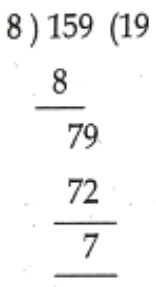
Remainder is zero.
∴ 159 is divisible by 8.
∴ 12159 is divisible by 8.
f) 14560
1) Test for divisibility by 4:
The number with last two digits = 60
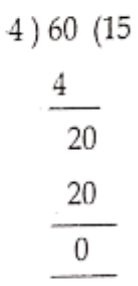
The remainder is zero.
∴ 60 is divisible by 4.
∴ 14560 is divisible by 4.
2) Test for divisibility by 8:
The number with last three digits = 560
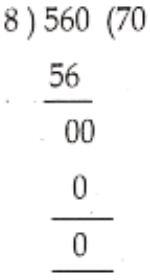
Remainder is not zero.
∴ 560 is not divisible by 8.
∴ 14560 is not divisible by 8.
g) 21084
1) Test for divisibility by 4:
The number with last two digits = 84
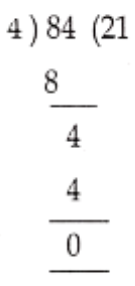
The remainder is zero.
∴ 84 is divisible by 4.1
∴ 21084 is divisible by 4.
2) Test for divisibility by 8:
The number with last two digits = 084.
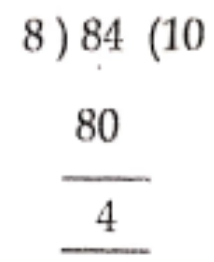
Remainder is not zero.
∴ 84 is not divisible by 8.
∴ 21084 is not divisible by 8.
h) 31795072
1) Test for divisibility by 4:
The number with last two digits = 50
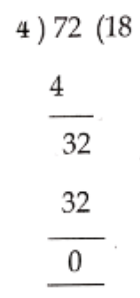
Remainder is zero.
∴ 72 is divisible by 4.
∴ 31795072 is divisible by 4.
2) Test for divisibility by 8:
The number with last three digits = 072
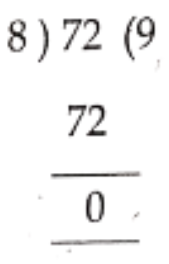
Remainder is zero.
∴ 72 is divisible by 8
∴ 31795072 is divisible by 8.
i) 1700
1) Test for divisibility by 4:
The number formed with last two digits = 00, which is always divisible by 4.
∴ 1700 is divisible by 4.
2) Test for divisibility by 8:
The number with last three digits = 700
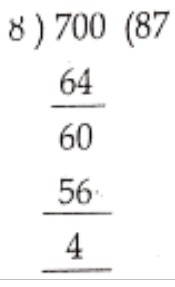
Remainder is not zero.
∴ 700 is not divisible by 8
∴ 1700 is not divisible by 8.
j) 2150
1) Test for divisibility by 4:
The number with last two digits = 50
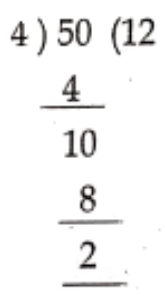
Remainder is not zero.
∴ 50 is not divisible by 4.
∴ 2150 is not divisible by 4.
2) Test for divisibility by 8:
The number with last three digits = 150
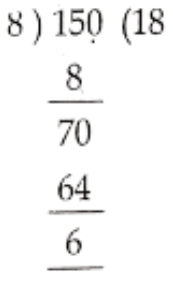
Remainder is not zero.
∴ 150 is not divisible by 8
∴ 2150 is not divisible by 8.
Divisibility rules Class 6 Haryana Board
Question 3. Using divisiblity tests, determine. which of the following numbers are divisible by 6:
Solution. 6 is divisible by 2, 3
a) 297144
1) Test for divisibility by 2: Units digit = 4 is divisible by 2.
∴ 297144 is divisible by 2.
2) Test for divisibility by 3:
Sum of digits = 2 + 9 + 7 + 1 + 4 + 4 = 27
27 is divisible by 3
∴ 297144 is divisible by 3.
Since 297144 is divisible by both 2 and 3, it is divisible by 6.
b) 1258
1) Test for divisibility by 2:
Units digit = 8 is divisible by 2.
∴ 1258 is divisible by 2.
2) Test for divisibility by 3:
Sum of digits = 1 + 2 + 5 + 8 = 16
16 is not divisible by 3
∴ 1258 is not divisible by 3.
∴ 1258 is not divisible by 3 but divisible by 2, So it is not divisible by 6.
c) 4335
1) Test for divisibility by 2:
Units digit = 5 is not divisible by 2.
∴ 4335 is not divisible by 2.
∴ 4335 is not divisible by 6.
d) 61233
1) Test for divisibility by 2:
Units digit = 3 is not divisible by 2.
∴ 61233 is not divisible by 2.
∴ 61233 is not divisible by 6.
e) 901352
1) Test for divisibility by 2:
Units digit = 2.
∴ 901352 is divisible by 2.
2) Test for divisibility by 3: Sum of the digits = 9 + 0 + 1 + 3 + 5 + 2 = 20.
20 is not divisible by 3
∴ 901352 is not divisible by 3.
∴ 901352 is not divisible by 6.
f) 438750
1) Test for divisibility by 2:
Units digit = 0 is always divisible by 2
∴ 438750 is divisible by 2.
2) Test for divisibility by 3:
Sum of digits = 4 + 3 + 8 + 7 + 5 + 0 = 27.
27 is divisible by 3
∴ 438750 is divisible by 3.
∴ 438750 is divisible by 2 and 3.
∴ 438750 is divisible by 6.
g) 1790184
1) Test for divisibility by 2:
Units digit = 4 is divisible by 2.
∴ 1790184 is divisible by 2.
2) Test for divisibility by 3:
Sum of the digits = 1 + 7 + 9 + 0 + 1 + 8 + 4 = 30
30 is divisible by 3
∴ 1790184 is divisible by 3.
1790184 is divisible by both 2 and 3.
∴ 1790184 is divisible by 6.
h) 12583
1) Test for divisibility by 2:
Units digit = 3 is not divisible by 2.
∴ 12583 is not divisible by 2.
∴ 12583 is not divisible by 6.
i) 639210
1) Test for divisibility by 2:
Units digit = 0
∴ 639210 is divisible by 2.
2) Test for divisibility by 3:
Sum of the digits = 6 + 3 + 9 + 2 + 1 + 0 = 21.
21 is divisible by 3
∴ 639210 is divisible by 3.
∴ 639210 is divisible by 2 and 3.
∴ 639210 is divisible by 6.
j) 17852
1) Test for divisibility by 2:
Units digit = 2
∴ 17852 is divisible by 2.
2) Test for divisible by 3:
Sum of the digits = 1 + 7 + 8 + 5 + 2 = 23
23 is not divisible by 3
∴ 17852 is divisible by 3.
∴ 17852 is not divisible by 6.
Question 4. Using divisibility tests, determine which of the following numbers are divisible by 11:
a) 5445
b) 10824
c) 7138965
d) 70169308
e) 10000001
f) 901153
Solution. a) 5445
Sum of the digits at odd places from the right = 5 + 4 = 9
Sum of the digits at even places from the right = 4 + 5 = 9
Difference = 9 – 9 = 0
‘0’ is divisible by 11.
∴ 5445 is divisible by 11.
b) 10824
Sum of the digits at odd places from the right = 4 + 8 + 1 = 13
Sum of the digits at even places from the right = 2 + 0 = 2
Difference = 13 – 2 = 11 divisible by 11
∴ 10824 is divisble by 11.
c) 7138965
Sum of the digits at odd places from the right = 5 + 9 + 3 + 7 = 24
Sum of the digits at even places from the right = 6 + 8 + 1 = 15
Difference = 24 – 15 = 9, not divisible by 11
∴ 7138965 is not divisible by 11.
d) 70169308
Sum of the digits at odd places from the right = 8 + 3 + 6 + 0 = 17
Sum of the digits at even places from the right = 0 + 9 + 1 + 7 = 17
Difference 17 – 17 = 0
‘0’ is divisible by 11
∴ 70169308 is divisible by 11.
e) 10000001
Sum of the digits at odd places from the right = 1 + 0 + 0 + 0 = 1
Sum of the digits at even places = 0 + 0 + 0 + 1 = 1
Difference = 1 – 1 = 0
‘0’ is divisible by 11.
∴ 10000001 is divisible by 11.
f) 901153
Sum of the digits at odd places from the right = 3 + 1 + 0 = 4
Sum of the digits at even places from the right = 5 + 1 + 9 = 15
Difference = 15 – 4 = 11
∴ 11 is divisible by 11
∴ 901153 is divisible by 11.
Question 5. Write the smallest digit and the greatest digit in the blank space of each of the following numbers so that the number formed is divisible by 3.
Solution. a) _6724
1) Smallest digit
Sum of the digits = 6 + 7 + 2 + 4 = 19
19 is not divisible by 3.
21 is the nearest number to 19 which is divisible by 3.
So, 2 is the smallest number that fills the blank.
∴ Smallest number is 2 i.e. 26724.
2) Largest digit
The largest digit is 8 (19 + 8 = 27)
b) 4765_2
Sum of the given digits
= 4 + 7 + 6 + 5 + 2 = 24
24 is divisible by 3
∴ Smallest digit is 0
Largest digit is 9.
Question 6. Write the digit in the blank space of each of the following numbers so that the number formed is divisible by 11:
a) 92_389
b) 8_9484
Solution. a) 92_389
The sum of digits at odd places from the right = 9 + 3 + 2 = 14
Sum of the digits at even places from the right = 8 + 9 = 17
Difference = 17 – 14 = 3
To make the difference divisible by 11, we have to add 8 to 3.
∴ Blank space must be 8.
∴ Required number-928389.
b) 8_9484
Sum of the digits at odd places from the right = 4 + 4 = 8
Sum of the digits at even places from the right = 8 + 9 + 8 = 25
Difference 25 – 8 = 17
To make the difference divisible by. 11, we have to deduct 6 from 17.
∴ Digit in the blank space = 6
∴ Required number = 869484.
Question 7. Find the common factors of
a) 8, 20
b) 9, 15
Solution. a) Factors of 8 are 1, 2, 4, 8.
Factors of 20 are 1, 2, 4, 5, 10, 20.
Common factors are 1, 2, 4.
b) Factors of 9 are 1, 3, 9.
Factors of 15 are 1, 3, 5, 15.
Common factors are 1, 3.
Chapter 3 Playing With Numbers Exercise 3.4
Question 1. Find the common factors of:
a) 20 and 28
b) 15 and 25
c) 35 and 50
d) 56 and 120.
Solution. a) 20 and 28.
Factors of 20 are 1, 2, 4, 5, 10 and 20.
Factors of 28 are 1, 2, 4, 7, 14 and 28.
Common factors are 1, 2, 4.
b) 15 and 25
Factors of 15 are 1, 3, 5 and 15.
Factors of 25 are 1, 5 and 25:
Common factors are 1,5.
c) 35 and 50
Factors of 35 are 1, 5, 7 and 35.
Factors of 50 are 1, 2, 5, 10, 25 and 50.
Common factors are 1, 5.
d) 56 and 120
Factors of 56 are 1, 2, 4, 7, 8, 14, 28, 56.
Factors of 120 are 1, 2, 3, 4, 5, 6, 10, 12, 20, 24, 30, 40, 60, 120.
Common factors are 1, 2, 4.
Question 2. Find the common factors of:
a) 4, 8 and 12
b) 5, 15 and 25
Solution. a) 4, 8 and 12
Factors of 4 are 1, 2, 4.
Factors of 8 are 1, 2, 4 and 8.
Factors of 12 are 1, 2, 3, 4, 6, 12.
Common factors are 1, 2 and 4.
b) 5, 15 and 25
Factors of 5 are 1 and 5.
Factors of 15 are 1, 3, 5 and 15.
Factors of 25 are 1,5 and 25.
Common factors are 1, 5.
Question 3. Find first three common multiples of:
a) 6 and 8
b) 12 and 18
Solution. a) 6 and 8
Multiples of 6 are 6, 12, 18, 24, 30, 30, 36, 42, 48, 54, 60, 66, 72, 78, ……….
Multiples of 8 are 8, 16, 24, 32, 40, 48, 56, 64, 72,…….
First three common multiples are 24, 48 and 72.
b) 12 and 18
Multiples of 12 are 12, 24, 36, 48, 60, 72, 84, 96, 108, 120, ………
Multiples of 18 are 18, 36, 54, 72, 90, 108, 126 …….
First three common multiples are 36, 72, 108.
Question 4. Write all the numbers less than 100 which are common multiples of 3 and 4.
Solution. The multiples of 3 are 3, 6, 9, 12, 15, 18, 21, 24, 27, 30, 33, 36, 39, 42, 45, 48, 51, 54, 57, 60, 63, 66, 69, 72, 75, 78, 81, 84, 87, 90, 93, 96, 99, 102, 105…..
Multiples of 4 are 4, 8, 12, 16, 20, 24, 28, 32, 36, 40, 44, 48, 52, 56, 60, 64, 68, 72, 76, 80, 84, 88, 92, 96, 100…..
Common multipies of 3 and 4 are 12, 24, 36, 48, 60,72, 84, 96, 108……
∴ Common multiples less than 100 are 12, 24, 36, 48, 60, 72, 84, 96
Question 5. Which of the following numbers are co-prime?
a) 18 and 35
b) 15 and 37
c) 30 and 415
d) 17 and 68
e) 216 and 215
f) 81 and 16
Solution. Two numbers having 1 as a common factor are called co-prime numbers.
a) 18 and 35
Factors of 18 are 1, 2, 3, 6, 9 and 18.
Factors of 35 are 1, 5, 7 and 35.
Common factor is 1.
∴ 18 and 35 are co-prime numbers.
b) 15 and 37
Factors of 15 are 1, 3, 5 and 15.
Factors of 37 are 1 and 37.
Common factor is 1.
∴ 15 and 37 are co-prime numbers.
c) 30 and 415
Factors of 30 are 1, 2, 3, 5, 6, 10, 15. and 30.
Factors of 415 are 1, 5, 83 and 415
Common factors are 1 and 5
∴ 30 and 415 are not co-primes.
d) 17 and 68
Factors of 17 are 1 and 17.
Factors of 68 are 1, 2, 4, 17, 34 and 68.
Common factors are 1 and 17.
∴ 17 and 68 are not co-prime numbers.
e) 216 and 215
Factors of 216 are 1, 2, 3, 4, 6, 8, 9, 12, 18, 24, 27, 36, 54, 72, 108 and 216.
Factors of 215 are 1, 5, 43, and 215.
Common factors is 1 only.
∴ 216 and 215 are co-prime numbers.
f) 81 and 16
Factors of 81 are 1, 3, 9, 27 and 81
Factors of 16 are 1, 2, 4, 8 and 16.
Common factor is 1.
∴ 81 and 16 are co-prime numbers.
Question 6. A number is divisible by both 5 and 12. By which other number will that number be always divisible?
Solution. The number divisible by both 5 and 12 is 60(12 × 5). The other number by which 60 is always divisible is 15. (15 × 4 = 60)
Question 7. A number is divisible by 12. By what other numbers will that number be divisible?
Solution. Factors of 12 are 1, 2, 3, 4, 6 and 12.
∴ The number is also divisible by 1, 2, 3, 4 and 6 also.
Question 8. Write the prime factorisation of 16, 28, 38.
Solution. 16 = 2 x 2 x 2 x 2
28 = 2 × 2 × 7
38 = 2 × 19
Haryana Board Class 6 Maths Solutions For Chapter 3 Playing With Numbers Exercise 3.5
Question 1. Here are two different factor trees for 60. Write the missing numbers.
a)
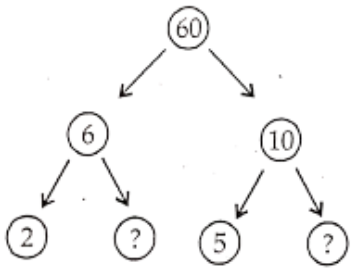
Solution.
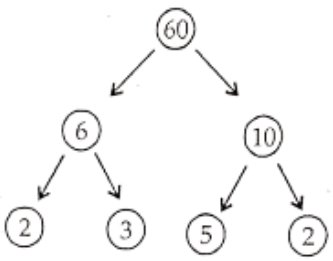
b)
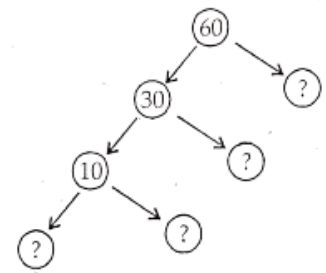
Solution.
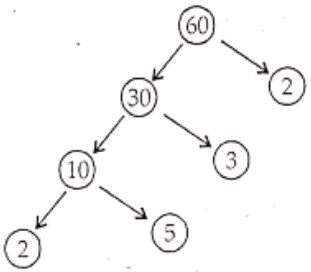
Question 2. Which factors are not included in the prime factorisation of a composite number?
Solution. 1 and composite factors are not included in the prime factorisation of a composite number.
Question 3. Write the greatest four digit number and express it in terms of its prime factors.
Solution. The greatest four digit number is 9999.
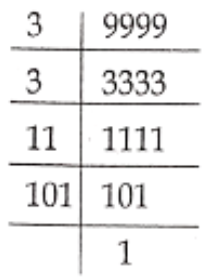
∴ 99993 x 3 x 11 x 101 x 1
Factors and multiples Class 6 HBSE
Question 4. Write the smallest five digit number and express it into the form of prime factors.
Solution. The smallest five digit number is 10000
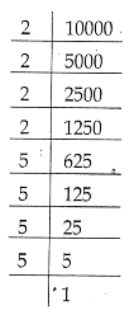
10000 = 2 x 2 x 2 x 2 x 5 x 5 x 5 x 5 x 1.
Question 5. Find all the prime factors of 1729 and arrange them in ascending order. Now state the relation, if any; between two consecutive prime factors.
Solution.
1729 = 7 x 13 × 19 × 1
All the prime factors of 1729 are 7, 13 and 19.
The ascending order is 7, 13, 19.
We, observe that the difference is the same between two consecutive prime factors.
13 – 7 = 6
19 – 13 = 6
Question 6. The product of three consecutive number is always divisible by 6. Verify this statement with the help of some examples.
Solution. Example 1:
Let us take three consecutive numbers be 21, 22 and 23.
21 is divisible by 3
22 is divisible by 2
∴ 21 x 22 is divisible by 6.
∴ 21 x 22 x 23 is divisible by 6.
Example 2:
Let the three consecutive numbers be 47, 48 and 49.
48 is divisible by both 2 and 3.
(2 x 3 = 6)
∴ 47 x 48 x 49 is divisible by 6.
Question 7. The sum of two consecutive odd num- ber is divisible by 4. Verify this statement with the help of some examples.
Solution. Example 1:
Let us take two consecutive odd numbers 13 and 15
Sum of the number = 13 + 15 = 28.
∴ 28 is divisible by 4.
Example 2:
Let the two consecutive odd numbers be 17 and 19
Sum of the numbers = 17 + 19 = 36
∴ 36 is divisible by 4.
Example 3:
Let the two consecutive odd numbers be 25 and 27.
Sum of the numbers = 25 + 27 = 52
∴ 52 is divisible by 4.
Question 8. In which of the following expressions, prime factorisation has been done?
a) 24 = 2 x 3 x 4
b) 56 = 7 x 2 x 2 x 2
c) 70 = 2 x 5 x 7
d) 54 = 2 × 3 × 9
Solution. a) Prime factorisation has been done.
b) Prime factorisation has not been done.
c) Prime factorisation has been done.
d) Prime factorisation has not been done.
Question 9. 18 is divisible by both 2 and 3. It is also divisible by 2 × 3 = 6. Similarly, a number is divisible by both 4 and 6. Can we say that the number must also be divisible by 4 × 6 = 24? If not, give an example to justify your answer.
Solution. No! we cannot conclude that the number will be divisible by 4 × 6 = 24 if it is divisible by both 4 and 6 because 4 and 6 are not co-prime numbers they have two common factors 1 and 2.
Example: 36 is divisible by 4 and 6 but 36 is not divisible by 24.
Question 10. I am the smallest number, having four different prime factors. Can you find me?
Solution. The four different prime factors = 2, 3, 5,7.
To find out the smallest number, we have to write them in their ascending order and multiply 2 × 3 × 5 × 7 = 210.
210 is the smallest number, having four different prime factors 2,3,5 and 7.
Question 11. Find the HCF of the following:
1) 24 and 36
2) 15, 25 and 30
3) 8 and 12
4) 12, 16 and 28.
Solution. 1) 24 and 36
Factors of 24 are 1, 2, 3, 4, 6, 8, 12 and 24.
Factors of 36 are 1, 2, 3, 4, 6, 9, 12, 18 and 36.
Highest common factor is 12.
∴ HCF of 24 and 36 is 12.
2) 15, 25 and 30
Factors of 15 are 1, 3, 5 and 15
Factors of 25 are 1,5 and 25
Factors of 30 are 1, 2, 3, 5, 6, 10, 15 and 30.
∴ HCF of 15, 25 and 30 is 5.
3) 8 and 12
Factors of 8 are 1, 2, 4 and 8
Factors of 12 are 1, 2, 3, 4, 6 and 12
HCF of 8 and 12 is 4.
4) 12, 16 and 28
Factors of 12 are 1, 2, 3, 4, 6 and 12
Factors of 16 are 1, 2, 4, 8 and 16
Factors of 28 are 1, 2, 4, 7, 14 and 28.
HCF of 12, 16 and 28 is 4.
Haryana Board Class 6 Maths Solutions For Chapter 3 Playing With Numbers Exercise 3.6
Question 1. Find the HCF of the following numbers:
a) 18, 48
b) 30,42
c) 18, 60
d) 27,63
e) 36,84
f) 34, 102
g) 70, 105, 175
h) 91, 112, 49
j) 12, 45, 75
i) 18, 54, 81
Solution. a) 18, 48
Factors of 18 are 1, 2, 3, 6, 9 and 18.
Factors of 48 are 1, 2, 3, 4, 6, 8, 12, 16, 24 and 48.
Common factors are 1, 2, 3 and 6.
∴ HCF of 18 and 48 is 6.
b) 30, 42
Factors of 30 are 1, 2, 3, 5, 6, 10, 15, and 30.
Factors of 42 are 1, 2, 3, 6, 7, 14, 21 and 42.
Common factors are 1, 2, 3 and 6.
∴ HCF of 30 and 42 is 6.
c) 18, 60
Factors of 18 are 1, 2, 3, 6, 9 and 18.
Factors of 60 are 1, 2, 3, 4, 5, 6, 10, 12, 15, 20, 30 and 60.
Common factors are 1, 2, 3, and 6.
∴ HCF of 18 and 60 is 6.
d) 27, 63
Factors of 27 are 1, 3, 9 and 27.
Factors of 63 are 1,3,7,9, 21 and 63.
Common factors are 1, 3 and 9.
∴ HCF of 27 and 63 is 9.
e) 36, 84
Factors of 36 are 1,2,3,4,6,9, 12, 18 and 36.
Factors of 84 are 1, 2, 3, 4, 7, 12, 14, 21, 42 and 84.
Common factors are 1, 2, 3, 4 and 12.
∴ HCF of 36 and 84 is 12.
f) 34, 102
Factors of 34 are 1, 2, 17 and 34.
Factors of 102 are 1, 2, 3, 6, 17, 34, 51 and 102.
Common factors are 1, 2, 17 and 34.
∴ HCF of 34 and 102 is 34.
g) 70, 105, 175
Factors of 70 are 1, 2, 5, 7, 10, 14, 35 and 70.
Factors of 105 are 1, 3, 5, 7, 15, 21, 35 and 105:
Factors of 175 are 1, 5, 7, 25, 35 and 175.
Common factors are 1, 5 and 35.
∴ HCF of 70, 105 and 175 is 35.
h) 91, 112, 49
Factors of 91 are 1, 7, 13 and 91.
Factors of 112 are 1, 2, 4, 7, 8, 14, 16, 28, 56 and 112.
Factors of 49 are 1, 7 and 49.
Common factors are 1 and 7.
∴ HCF of 91, 112, 49 is 7.
i) 18, 54, 81
Factors of 18 are 1, 2, 3, 6, 9 and 18.
Factors of 54 are 1, 2, 3, 6, 9, 18, 27 and 54.
Factors of 81 are 1, 3, 9, 27 and 81.
Common factors are 1, 3, 9.
∴ HCF of 18, 54, 81 is 9.
j) 12, 45, 75
Factors of 12 are 1, 2, 3, 4, 6 and 12.
Factors of 45 are 1,3,5,9, 15 and 45.
Factors of 75 are 1, 3, 5, 15, 25 and 75.
Common factors are 1 and 3.
∴ HCF of 12, 45 and 75 is 3.
Question 2. What is the HCF of two consecutive.
a) Numbers ?
b) Even numbers?
c) Odd numbers?
Solution. a) Numbers
HCF of two consecutive numbers is 1.
b) Even numbers
HCF of two consecutive even number is 2.
c) Odd numbers
HCF of two consecutive odd numbers is 1.
Question 3. HCF of co-prime numbers 4 and 15 was found as follows by factorisation : 4 = 2 × 2 and 15 = 3 x 5 since there is no common prime factor, so HCF of 4 and 15 is 0. Is the answer correct? If not, what is the correct HCF?
Solution. No, the answer is not correct.
The HCF of 4 and 15 is 1.
Haryana Board Class 6 Maths Solutions For Chapter 3 Playing With Numbers Exercise – 3.7
Question 1. Renu purchases two bags of fertiliser of weights 75 kg and 69 kg. Find the maximum value of weight which can measure the weight of the fertiliser exact number of times.
Solution. Factors of 75 are 1, 3, 5, 15, 25 and 75
Factors of 69 are 1, 3, 23 and 69.
Common factors are 1 and 3.
HCF of 75 and 69 is 3.
The maximum capacity of weight which can measure the weight of the fertiliser exact number of times is 3 kg.
Question 2. Three boys step off together from the same spot. Their steps measure 63 cm, 70 cm and 77 cm respectively. What is the minimum distance each should cover so that all can cover the distance in complete steps?
Solution.
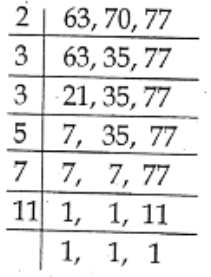
LCM of 63, 70 and 77
= 2 x 3 x 3 x 5 x 7 x 11 = 6930
The minimum distance each should cover so that all cover the distance in complete steps is 6930 cm. or 69 m 30 cm.
Word problems on HCF and LCM for Class 6 HBSE
Question 3. The length, breadth and height of a room are 825 cm, 675 cm and 450 cm respectively. Find the longest tape which can measure the three dimen- sions of the room exactly.
Solution. Factors of 825 are 1, 3, 5, 11, 15, 25, 33, 55, 75, 165, 275 and 825.
Factors of 450 are 1, 2, 3, 5, 6, 9, 10, 15, 18,25,30,45,50, 75, 90, 150, 225 and 450.
Common factors are 1, 3, 5, 15, 25 and 75.
HCF = 75
The length of largest tape which can measure the three dimensions of the room exactly is 75 cm.
Question 4. Determine the smallest 3-digit number which is exactly divisible by 6, 8 and 12.
Solution.
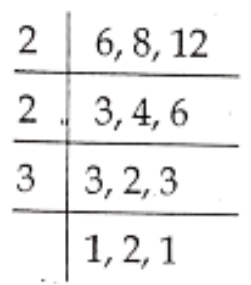
L.C.M = 2 x 2 x 3 x 1 x 2 x 1 = 24
Multiples of 24 are 24, 48, 72, 96, 120, 144……
The smallest 3-digit number which is exactly divisible by 6, 8 and 12 is 120.
Question 5. Determine the greatest 3-digit num- ber exactly divisible by 8, 10 and 12.
Solution.
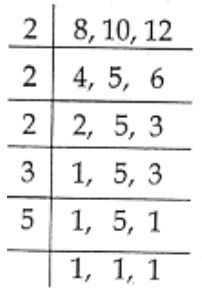
LCM = 2 × 2 × 2 × 3 × 5 = 120
Multiples of 120 are 120, 240, 360, 480, 600, 720, 840, 960, 1080 ……….
∴ The largest 3-digit number exactly divisible by 8, 10 and 12 is 960.
Question 6. The traffic lights at three different road crossings change after every 48 seconds, 72 seconds and 108 seconds respectively. If they change simultaneously at 7 a.m. at what time will they change simultaneously again?
Solution.
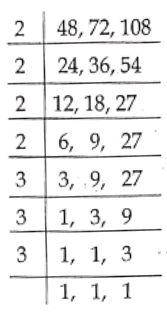
L.C.M. = 2 x 2 x 2 x 2 x 3 x 3 x 3 = 432
432 seconds = \(\frac{432}{60}\) = 7 min. 12 seconds.
(1 minute = 60 secs)
∴ They will change simultaneously again at 7 min. 12 seconds after 7 am:.
Question 7. Three tankers contain 403 litres, 434 litres and 465 litres of diesel respectively. Find the maximum capacity of a container that can measure the diesel of the three containers exact number of times.
Solution. Factors of 403 are 1, 13, 31 and 403.
Factors of 465 are 1, 3, 5, 15, 31, 93, 155 and 465.
Factors of 434 are 1, 2, 7, 14, 31, 62, 217 and 434.
Common factors are 1 and 31. HCF = 31 The maximum capacity of the container that can measure the diesel of the three containers exact number of times is 31 litres.
Question 8. Find the least number which when divided by 6, 15 and 18 leave remainder 5 in each case.
Solution.
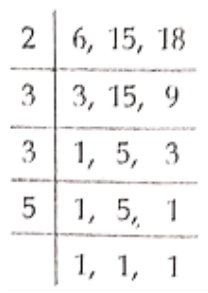
LCM = 2 x 3 x 3 x 5 = 90
∴ Required number = 90 + 5 = 95.
Question 9. Find the smallest four digit number which is divisible by 18, 24 and 32.
Solution.
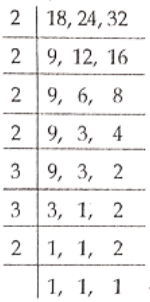
LCM = 2 × 2 × 2 x 2 x 3 x 3 x 2 = 288
Multiples of 288 are 288 × 1
288 × 1 = 288
288 x 2 = 576
288 × 3 = 864
288 x 4 = 1152
∴ The smallest 4-digit number which is divisible by 18, 24 & 32 is 1152.
Question 10. Find the LCM of the following numbers:
a) 9 and 4
b) 12 and 5
c) 6 and 5
d) 15 and 4.
Solution. a) 9 and 4
LCM of 9 and 4 is 9 x 4 = 36
b) 12 and 5
LCM of 12 and 5 is 12 x 5 = 60
c) 6 and 5
LCM of 6 and 5 is 6 x 5 = 30
d) 15 and 4
LCM of 15 and 4 is 15 x 4 = 60
We observe a common property in the obtained LCM’s that the LCM is the product of two numbers in each case and also the LCM is always a multiple of 3.
Question 11. Find the LCM of the following numbers in which one number is the factor of the other.
a) 5,20
b) 6, 18
c) 12,48
d) 9,45
What do you observe in the results obtained?
Solution. a) 5, 20
5 = 5 x 1
20 = 2 × 2 × 5
LCM of 5 and 20 = 2 x 2 x 5 = 20
b) 6,18
6 = 2 × 3
18 = 2 x 3 x 3
LCM of 6 and 18 is 2 × 3 × 3 = 18
c) 12, 48
12 = 2 × 2 × 3
48 = 2 x 2 x 2 × 2 × 3
LCM of 12 and 48
= 2 × 2 × 2 × 2 × 3 = 48.
d) 9, 45
9 = 3 × 3
45 = 3 × 3 × 5
LCM of 9 and 45 = 3 x 3 x 5 = 45
In the results obtained, we observe that the LCM of the two numbers in which one number is a factor of the other is the greater number.
Haryana Board Class 6 Maths Solutions For Chapter 3 Playing With Numbers Very Short Answer Questions
Question 1. Are the numbers 452, 673, 259, 356 divisible by 2? Verify.
Solution. A number is divisible by 2, if it has any of the digits 0, 2, 4, 6 and 8 in its ones place.
∴ The numbers 452 and 356 have 2 and 6 in their ones place and the other num- bers does not have.
∴ 452 and 356 are divisible by 2.
Question 2. Is 8430 divisible by 6? Why?
Solution. If a number is divisible by both 2 and 3 then it is also divisible by 6.
The ones place of 8430 is 0, so it is divisible by 2.
The sum of digits of 8430 is 8 + 4 + 3 + 0 = 15.
15 is multiple of 3. So 8430 is divisible by 3.
∴ The number 8430 is divisible by both 2 and 3. It is divisible by ‘6’.
Question 3. Test whether 6669 is divisible by 9.
Solution. The sum of digits of 6669
= 6 + 6 + 6 + 9 = 27
It is a multiple of 9. So the number 6669 is divisible by 9.
Question 4. Without actual division, find whether 8989794 is divisible by 9.
Solution. The sum of digits of 8989794
= 8 + 9 + 8 + 9 + 7 + 9 + 4 = 54
It is a multiple of 9. So the number 8989794 is divisible by 9.
Question 5. Find the smallest number that must be added to 128, so that it becomes exactly divisible by 5.
Solution. Given number is 128
If the number is exactly divisible by 5, its ones place should have the digits 5 or 0.
∴ The nearest number to 128 which is having 0 or 5 in one’s place is 130.
∴ The smallest number that must be added is 130 – 128 = 2
Question 6. What is the smallest prime number?
Solution. 2 is the smallest prime number.
Question 7. What is the smallest composite number?
Solution. 4 is the smallest composite number.
Question 8. What is the smallest odd prime number?
Solution. 3 is the smallest odd prime number.
Question 9. What is the smallest odd composite number?
Solution. 9 is the smallest odd composite number.
Question 10. Write 10 odd and 10 even composite numbers.
Solution. 10 odd composite numbers = 9, 15, 21, 25, 27, 33, 35, 39, 45, 49.
10 even composite numbers = 4, 6, 8, 10, 12, 14, 16, 18, 20, 22.
Haryana Board Class 6 Maths Solutions For Chapter 3 Playing With Numbers Short Answer Questions
Question 11. Are the numbers 28570, 90875 divisible by 5? Verify by actual division also.
Solution. The number with zero or five at ones place is divisible by 5.
In the numbers 28570 and 90875; the digits at ones place are 0 and 5. So these numbers are divisible by 5.
Verifying by actual division:
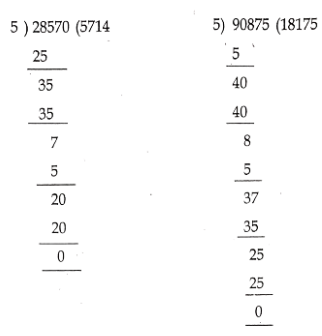
Question 12. Find the smallest number that has to be subtracted from 276 so that it becomes exactly divisible by 10.
Solution. Given number is 276
The digit in ones place is 6.
For the number exactly divisible by 10, the digit in ones place must be ‘0’
∴ The smallest number that has to be subtracted = 276 – 6 = 270
∴ The smallest number that has to be subtracted is 6.
Question 13. Write the greatest four digit number which is divisible by 9. Is it divisible by 3? What do you notice?
Solution. The greatest four digit number which is divisible by 9 is 9999.
∴ The sum of digits = 9 + 9 + 9 + 9 = 36
36 is divisible by 3.
∴ 9999 is divisible by 3.
∴ Yes, the greatest four digit number which is divisible by 9 is also divisible by 3.
∴ We noticed that the numbers which are divisible by 9 are also divisible by 3.
Question 14. Write the nearest number to 12345 which is divisible by 4.
Solution. A number is divisible by 4 if the number formed by the last two digits is divisible by 4.
Given number is 12345.
Number formed by last two digits is 45.
If 1 is subtracted from it.
45 – 1 = 44 is divisible by 4.
So the nearest number to 12345 divisible by 4 is 12344.
Question 15. Find the factors of 60.
Solution. Factors of 60 = 1 × 60
= 2 x 30
= 3 x 20
= 4 x 15
= 5 x 12
= 6 x 10.
= 10 x 6
= 12 x 5
= 15 x 4
= 20 x 3
= 30 x 2
= 60 × 1
∴ The factors of 60 are = 1, 2, 3, 4, 5, 6, 10, 12, 15, 20, 30 and 60.
Chapter 3 Playing With Numbers Long Answer Questions
Question 16. Take any three 4 digit numbers and check whether they are divisible by 6.
Solution. Let us take three four digits numbers.
1) 3420 2) 7942 3) 6036
1) 3420
The ones place of 3420 is 0. So it is divisible by 2.
The sum of digits = 3 + 4 + 2 + 0 = 9.
It is divisible by 3.
∴ The number 3420 is divisible by both 2 and 3. So it is divisible by 6 also.
2) 7942
The ones place of 7942 is 2. So it is divisible by 2.
The sum of digits = 7 + 9 + 4 + 2 = 22.
It is not divisible by 3.
∴ The number 7942 is divisible by 2 but not divisible by 3. So it is not divisible by 6.
3) 6036
The ones place of 6036 is 6. So it is divisible by 2.
The sum of digits = 6 + 0 + 3 + 6 = 15.
It is divisible by 3.
∴ The number 6036 is divisible by both 2 and 3. So it is divisible by 6 also.
Question 17. Check whether the numbers 598, 864, 4782 and 8976 are divisible by 4. Use divisibility rule and verify by ac- tual division.
Solution. Divisibility rule of 4:
A number is divisible by 4 if the number formed by its last two digits. (i.e., ones and tens) is divisible by 4.
1) 598
The number formed by last two digits is 98.
98 is not divisible by 4.
∴ 598 is not divisible by 4.
2) 864
The number formed by last two digits is 64.
64 is divisible by 4.
∴ 864 is divisible by 4.
3) 4782
The number formed by last two digits is 82.
82 is not divisible by 4.
∴ 4782 is not divisible by 4.
4) 8976
The number formed by last two digits is 76.
76 is divisible by 4.
∴ 8976 is divisible by 4.
Question 18. Determine which of the following numbers are divisible by 5 and by 10.
25, 125, 250, 1250, 10205, 70985, 45880.
Check whether the numbers that are divisible by 10 are divisible by 2 and 5.
Solution. 25, 125, 10205, 70985, 250, 1250, 45880
These numbers are having ‘5’ or ‘0’ in the ones place.
∴ These numbers are divisible by 5
250, 1250, 45880
These numbers having ‘0’ in the ones place
∴ These numbers are divisible by 10
These numbers are divisible by ‘5’
these numbers are having ‘0’ in the ones place,
These numbers are also divisible by 2
∴ The numbers which are divisible by 10 are divisible by 2 and 5 also.
Difference between factors and multiples Class 6
Question 19. Write all the numbers between 100 and 200 which are divisible by 6.
Solution. The numbers divisible by 2 and 3 are divisible by 6.
The numbers divisible by 2 between 100 and 200 are = 102, 104, 106, 108, 110, 112, 114, 116, 118, 120, 122, 124 ………… 196, 198
The numbers divisible by 3 between 100 and 200 are = 102, 105, 108, 111, 114, 117, 120, 123, 126 …….. 195,198
The numbers which are divisible by both 2 and 3 are = 102, 108, 114, 120, 126, 132, 138, 144, 150, 156, 162, 168, 174, 180, 186, 192, 198
So all these numbers are divisible by 6.
Question 20. Using divisibility rules, determine which of the following numbers are divisible by 11.
1) 6446
2) 10934
3) 7138965
4) 726352
Solution. A number is divisible by 11, if the difference between the sum of the digits at odd places and the sum of the digits at even places (from the right) is either ‘0’ or multiple of 11.
1) 6446
The sum of digits at odd places = 6 + 4 = 10
The sum of digits at even places = 4 + 6 = 10
∴ Their difference = 10 – 10 = 0
So 6446 is divisible by 11.
2) 10934
The sum of digits at odd places = 4 + 9 + 1 = 14
The sum of digits at even places = 3 + 0 = 3
∴ Their difference = 14 3 = 11
It is a multiple of 11.
So 10934 is divisible by 11.
3) 7138965
The sum of digits at odd places = 5 + 9 + 3 + 7 = 24
The sum of digits at even places = 6 + 8 + 1 = 15
∴ Their difference = 24 – 15 = 9
It is not a multiple of 11.
So 7138965 is not divisible by 11.
4) 726352
The sum of digits at odd places = 2 + 3 + 2 = 7
The sum of digits at even places = 6 + 8 + 1 = 15
∴ Their difference = 18 – 7 = 1
It is a multiple of 11.
So 726352 is divisible by 11.
Haryana Board Class 6 Maths Solutions For Chapter 3 Playing With Numbers Objective Type Questions
Choose the correct answer :
Question 1. In the following which is a composite number?
- 0
- 1
- 2
- 4
Answer. 4. 4
Question 2. Is 107 a prime number?
- yes
- no
- can’t say
- infinite
Answer. 1. yes
Question 3. Divide 29 by 4 it gives quotient
- 1
- 7
- 6
- 4
Answer. 2. 7
Question 4. A number is completely divisible by another number it leaves a remainder
- 1
- 2
- 3
- 0
Answer. 4. 0
Question 5. Which of the following numbers is divisible by 9?
- 197235
- 726352
- 988975
- 345880
Answer. 1. 197235
Question 6. Factors of 12 are
- 2,3
- 1,2,3
- 1,2,3,4,6
- 1, 2, 3, 4, 6, 12
Answer. 4. 1, 2, 3, 4, 6, 12
Question 7. The HCF of two consecutive numbers is
- 1
- The smallest number
- The greatest number
- 0
Answer. 1. 1
Question 8. The greatest two digit prime number.
- 77
- 79
- 97
- 99
Answer. 3. 97
Question 9. The number of factors of 80
- 8
- 10
- 11
- 12
Answer. 2. 10
Question 10. The another name for GCD
- LCM
- HCF
- GCM
- LCF
Answer. 2. HCF
Question 11. The number divisible by 4
- 200094
- 249874
- 249884
- 249854
Answer. 3. 249884
Question 12. The least two digit prime number
- 11
- 10
- 12
- 13
Answer. 1. 11
Question 13. 512215 is divisible by …..
- 2
- 4
- 11
- 6
Answer. 3. 11
Question 14. Example for twin prime numbers.
- (41,43)
- (42, 44)
- (43,45)
- (44, 46)
Answer. 1. (41,43)
Question 15. Number of common factors of 12 and 18 is
- 3
- 4
- 6
- 8
Answer. 2. 4
Question 16. The least prime number is
- 2
- 3
- 4
- 1
Answer. 1. 2
Question 17. 51225 is divisible by.
- 51
- 2
- 4
- 5
Answer. 4. 5
Question 18. HCF of 3, 4 is.
- 0.5
- 1
- 2
- 3
Answer. 2. 1
Question 19. Choose the correct matching.
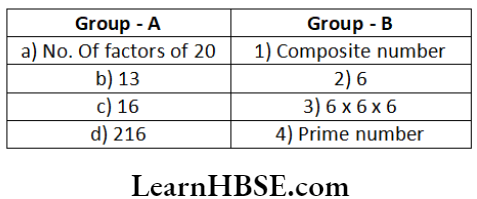
- a-4, b-2, c-3, d-1
- a-1, b-4, c-2, d-3
- a-4, b-2, c-1, d-3
- a-2, b-4, c-1, d-3
Answer. 4. a-2, b-4, c-1, d-3
Question 20. Which of the following is not divisible by 2?
- 11150
- 63874
- 81111
- 1496
Answer. 3. 81111
Question 21. Greatest factor of 120 is………….
- 8
- 15
- 120
- 12
Answer. 3. 120
Question 22………… is neither prime nor composite.
- 4
- 3
- 1
- 2
Answer. 3. 1
Question 23. LCM of 8 and 12 is…………….
- 11
- 13
- 12
- 24
Answer. 4. 24
Question 24. HCF of 40, 56 and 60 is…………….
- 8
- 4
- 60
- 16
Answer. 2. 4
Question 25. How many prime numbers less than 100 are there?
- 15
- 25
- 30
- 26
Answer. 2. 25
Question 26. 42 = ……………..
- 7 × 3 × 2
- 7 × 7 x 9
- 2 × 21 × 3
- 7 × 6 × 4
Answer. 1. 7 x 3 x 2
Question 27. Identify a palindrome number.
- 1225
- 1331
- 11452
- 31119
Answer. 2. 1331
Question 28. 2 x 2 × 3 × 7 = ……….
- 84
- 62
- 81
- 22
Answer. 1. 84
Question 29. Number of factors of 36 is ………
- 6
- 11
- 10
- 9
Answer. 9
Question 30. The smallest odd composite number is …..
- 17
- 15
- 9
- 16
Answer. 3. 9
Question 31. Identify the correct statement from the following:
- 733 is divisible by 3
- The greatest prime number after 20 is 23
- 4, 6, 8, 10, 12 are even composite numbers
- 7221 is a factor of 11
Answer. 3. 4, 6, 8, 10, 12 are even composite numbers
Question 32. Factors of 115 are.
- 5
- 23
- 115
- All the above
Answer. All the above
Question 33. How many prime numbers are there in between 10 and 30?
- 9
- 6
- 8
- 19
Answer. 2. 6
Question 34. 9846 is not divisible by …….
- 9
- 3 only
- 2 only
- 5
Answer. 5
Question 35. Sum of the digits of 36129 is
- 16
- 3
- 21
- 8
Answer. 3. 21
Question 36. How many twin primes are below 20?
- 5
- 6
- 3
- 4
Answer. 4. 4
Question 37. 53 = …………..
- 13 + 17 + 20
- 13 + 17 + 23
- 18 + 10 + 16
- 17 + 13 + 33
Answer. 2. 13 + 17 + 23
Question 38. HCF of 28, 35 is ………
- 6
- 9
- 7
- 8
Answer. 7
Question 39. LCM of 10 and 11 is ……..
- 119
- 122
- 111
- 110
Answer. 4. 110
Question 40. LCM of a and b if HCF of a, b = 1.
- \(\frac{a}{b}\)
- a+b
- ab
- a-b
Answer. 3. ab
Question 41. Two prime numbers are said to be twin primes, if they differ each other by
- 0
- 1
- 2
- None
Answer. 3. 2
Question 42. Choose the correct matching.
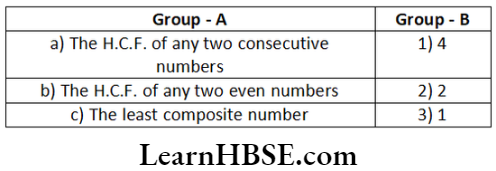
- a-1, b-2, c-3
- a-3, b-2, c-1
- a-1, b-3, c-2
- a-2, b-3, c-1
Answer. 2. a-3, b-2, c-1
Question 43. The numbers which have 1 as the common factor are called…….
- co-prime
- relatively prime
- Both A & B
- None
Answer. 3. Both A & B
Question 44. The H.C.F. of any two twin primes is………….
- 0
- 1
- 2
- None
Answer. 2. 1
Question 45. The product of L.C.M and H.C.F of two numbers =
- Sum of two numbers
- Difference of two numbers
- Both A & B
- Product of two numbers
Answer. 4. Product of two numbers
Question 46. A number which divides the other number with out remainder is called
- factor
- multiple
- prime number
- composite number
Answer. 1. factor
Question 47. The number which is divisible by 1 and itself is called
- factor
- multiple
- prime number
- composite number
Answer. 3. Prime number
Question 48. If the L.C.M of 8 and 12 is 24 then their H.C.F. is
- 3
- 4
- 16
- 96
Answer. 2. 4
Question 49. If the H.C.F. of 18 and 27 is 9 then their L.C.M is
- 9
- 486
- 54
- None
Answer. 3. 54
Question 50. ……………. is a factor of 12.
- 7
- 9
- 4
- 18
Answer. 3. 4
Question 51. ……………… is a factor of every number.
- 3
- 12
- 0
- 1
Answer. 4. 1
Question 52. The fifth multiple of 6 is.
- 30
- 35
- 40
- 45
Answer. 1. 30
Question 53. Every prime number except ………. is odd.
- 3
- 4
- 1
- 2
Answer. 4. 2
Question 54. 128 is divisible by
- 4
- 3
- 5
- 9
Answer. 1. 4
Question 55. 2 x 2 x 2 x 2 = ……….
- 18
- 8
- 12
- 16
Answer. 4. 16
Question 56. HCF of 24 and 36 is ….
- 14
- 36
- 12
- 24
Answer. 3. 12
Question 57. LCM of 24 and 90 is …..
- 360
- 300
- 460
- 306
Answer. 1. 360
Question 58. Which of the following number is divisible by 2?
- 133
- 124
- 135
- 111
Answer. 2. 124
Question 59. Two numbers having only 1 as a common factor are called …………..numbers.
- co-prime
- prime
- odd
- even
Answer. 1. co-prime
Question 60. Which of the following number is not divisible by 5?
- 140
- 222
- 1000
- 110
- Answer. 2. 222
Haryana Board Class 6 Maths Solutions For Chapter 3 Playing With Numbers Fill In The Blanks:
Question 61. HCF of 2021 and 2022 is
Answer. 1
Question 62. The least composite number is ………..
Answer. 4
Question 63. Number of primes below 98 is ………..
Answer. 25
Question 64. LCM of 2, 4, 6 ………………..
Answer. 12
Question 65. HCF of 3, 5, 19 is …………
Answer. 1
Question 66.
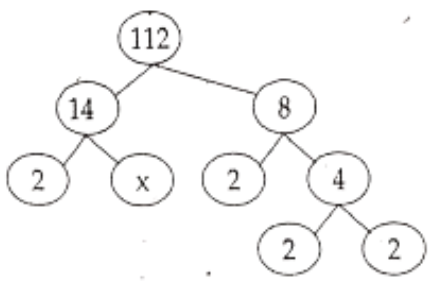
In the above factor tree of 112 the value of x = ………..
Answer. 7
Question 67. HCF of 30 and 48 is ……………
Answer. 6
Question 68. HCF of two consecutive even numbers is ………….
Answer. 2
Question 69. Express 44 as sum of two odd primes ………….
Answer. 13 + 31
Question 70. Number of factors of 80 is …………..
Answer. 10
Question 71. 2, 4, 6, 8 are examples of ………….numbers.
Answer. even
Question 72. 2 × 3 + 1 = …………
Answer. 7
Question 73. …………….. is neither a prime nor a composite number
Answer. 1
Question 74. 4 × 17 = ……………..
Answer. 68
Question 75. Number of factors of a given number are.
Answer. finite
Question 76. Every number is a factor of ………..
Answer. itself
Question 77. 1, 2, 4 are called …………………..
Answer. factors
Question 78. Sum of the digits of a number is divisible by 3, then it is divisible by
Answer. 3
Question 79. LCM of 8 and 12 is. ……….
Answer. 24
Question 80. HCF of any two consecutive numbers is ………..
Answer. 1
Question 81. LCM means ………….
Answer. Least Common Multiple
